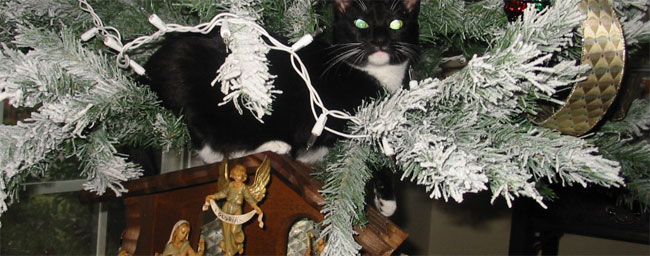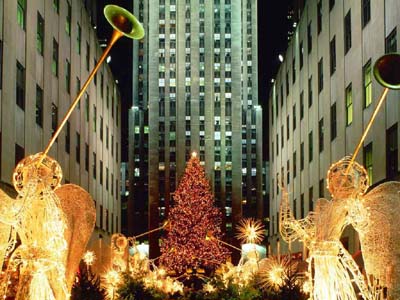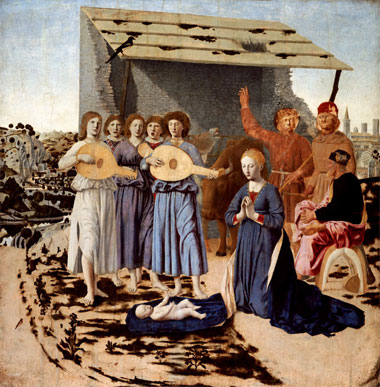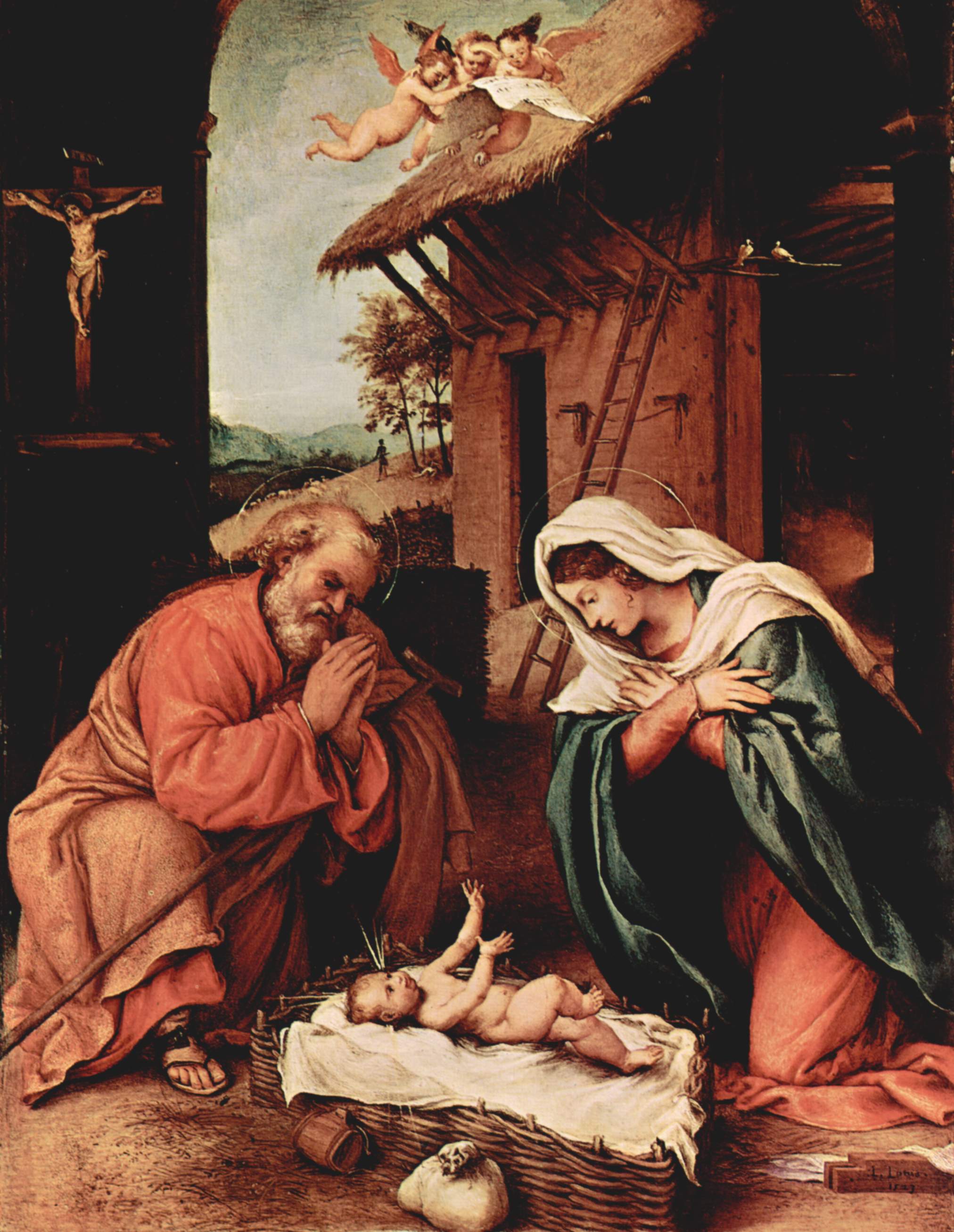
| 2008 Skelly Family Holiday Celebration Website
"A cold coming we had of it, Just the worst time of the year For a journey, and such a long journey:" |
 |
| Christmas Weblog | Christmas Past | Christmas Present | Christmas Yet to Come |
| Christmas '07 |
| Christmas '06 |
| Christmas '05 |
| Christmas '04 |
| Christmas '03 |
| Christmas '02 |
| Christmas '01 |
| Christmas '00 |
| Christmas '99 |
|
The Nativity through the Ages in Art, Music and Literature
Whoa, kind of pompous, huh? Canít you just feel your eyelids getting heavy? Not to worry. This topic will be dealt with in the same casual, slapdash way youíve come to expect from this Christmas website. This should only take a minute.
Basically it comes down to this. Poets, songwriters and painters just wallow in Nativity themes; prose writers (novelists and dramatists) not so much. And no wonder: Thereís no story there for them. You're pretty much done working after the first paragraph. Our early ancestors knew there was little to be found at the beginning of a personís life. Thatís why they tended not to commemorate famous peopleís births but rather their deaths. The Church didnít get around to celebrating the birth of Jesus until 400 AD, and even that was, in large part, a defensive parry. Only two of the gospels even mention the Nativity. Matthew gives it about 300 words, mostly devoted to Herod and the Wise Men. (And now comes word that the murder of all those two-year olds is likely just a myth. Take that, you biblical literalists. This January you can cancel your subscriptions to both Sports Illustrated and National Geographic.) Anyway, no shepherds in the field or angels in the sky for Matthew. Luke does the birth of Christ the most justice, but even he gives it all of 400 words. From then until now, not too many other long writers have worked the subject very hard. Painters and poets and minstrels, that's another story entirely. The Nativity makes a great spectacle. Art, poetry and music are much more about the moment. Thereís nothing going on in any Nativity play until the last scene, and then: Voila, a painting! 
John Milton wrote possibly the definitive Nativity poem in 1629: On the Morning of Christís Nativity. This is the guy who gave us our conceptions of hell, angels and, of course, the devil (surprisingly human). The gospels talked about these things, but Milton brought them to life, gave them form and physical image, breathed personality into them. Matthew, Mark, Luke and John may have been divinely inspired, but Milton was a better writer. Beyond Milton, a legion of other English poets have celebrated Christ's birth in verse including Robert Southwell, John Donne, Ben Jonson, Francis Quarles, Robert Herrick, George Herbert, Richard Crashaw, Joseph Beaumont, Henry Vaughan, Rowland Watkyns and Mildmay Fane, Second Earl of Westmoreland. Many of them more than once. Interestingly, Milton's Nativity comes in only fifth on this modern ranking of Christmas poems.
Only two of those are Nativity-centric, which suggests something else that might be going on. Music, art and poetry are older, novels a relatively recent invention. Way back when, our culture was more overtly religious. Our European ancestors weren't better people, they just didn't have much else going on other than religion. Until the Renaissance (and the invention of the printing press), religion was basically the center of consciousness. The liturgical calendar served as the nexus of daily existence. Along with debauchery and incest, drinking themselves into a stupor when they had the time, and working themselves into an early grave when they didn't. Or just getting pointlessly killed when they got in the way of some nobleman. But the mindset of writers nowadays is in a whole 'nother place. From Dickens to Dostoyevsky to Truman Capote, writers like to wallow in human misery even when they're celebrating the triumph of the human spiritóand actually the latter doesn't happen that often. What do guys like Hemmingway know about Christmas? They're way too busy being desperate to be uplifting. Their idea of a good day is getting ground into dust while keeping your dignity. Like The Old Man and the Sea, a story I never did understand. But presumably these guys represent a popular, more secular mindset. What modern writers write is what modern people like. Or maybe the people who put this list together were just idiots. Shakespeare mentioned Christmas only three times in but two of his plays and the Nativity only once (Hamlet). And no modern he. Though his plays were in verse, each one is, after all, a long story. Not a lot from his fellow dramatists on Nativity themes either. Drama does offer the example of the iconic Nativity Play, even if there are no famous ones left over from antiquity. The Nativity by Piero della Francesca (1470-5)

|
The Nativity by Lorenzo Lotto (1573)

You might think of Hollywood as the triumph of spectacle over plot, but movie makers have tended to follow the prose writers in their treatment of Christmas. And why not? Everybody thinks they're a writer out there. And better than the real ones. Lots of warm sentiment and blue melancholy and even the miracle of hope in the face of insurmountable odds, but in the hundreds of Christmas films made for the big screen and TV, there are precious few nativity-based stories.
Check it out for yourself. This yearís Christmas website features an interactive Christmas movie search engine for you to play with. Yup, toys! Look up your favorite movie, find out who directed it, who starred in it, when it was produced and whether the lords of movie ranking thought it was any good. Click here. There's plenty of Nativity paintings. From the Renaissance period mainly, but that's when a lot of great art was done. Although a lot of Nativity art may not be great art. None cracks the top ten of Listology's greatest paintings list. Rubens's The Adoration of the Magi comes in at #20. www.listology.com The Pittsburgh Tribune-Review recently published the American Society of Composers, Authors and Publishers list of the most popular holiday songs for the past five years, based on number of performances. It shows a similarly secular cast. Little Drummer Boy is the only Nativity-themed opus to crack the top ten. But one suspects something else is afoot here. Maybe they're only counting songs that royalties are still being paid on.
|